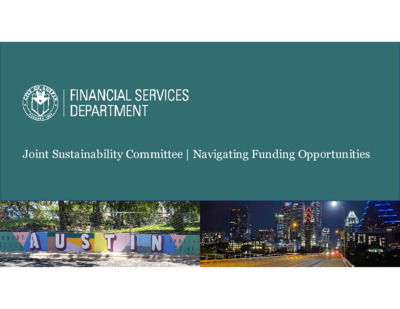2. Navigating Funding Opportunities — original pdf
Backup

Joint Sustainability Committee | Navigating Funding Opportunities Council Resolution Key Takeaways • Identify capital improvements and programs that would maximize potential Inflation Reduction Act tax credits, and develop a mechanism for reinvestments of reimbursement from such credits into similarly climate focused capital improvements and programs. • Review and identify which investments from the Committee have the option of being funded through utility rates and fees, general fund expenditures, grants, and/or bond instruments. Resolution: https://services.austintexas.gov/edims/document.cfm?id=424874 Funding Sources FY 2024 All City Operating Funds – $5.5 Billion Convention Center 5% Aviation 5% Austin Water 13% Austin Resource Recovery 2% General Fund Operations 24% GO Debt Service 4% Internal Service Operations 7% Other Expenses 6% Watershed Protection 2% Austin Energy 28% Transportation and Public Works 4% Funding Sources Utility Rates and Fees • $1.7 billion projected revenue for FY 2024. • 90% from rates and 10% from fees. • AE’s major expenditures include power supply costs, wholesale transmission costs, operating and maintenance expenses, debt service, investment in capital improvements, and transfers to the City’s General Fund. • Energy Efficiency Programs funded by the Community Benefit Charge include: • Rebates and incentives for energy efficiency improvements • Rebates for installation of rooftop solar systems • Austin Energy Green Building Program Funding Sources Utility Rates and Fees • $698.2 million projected revenue for FY 2023‐24. AW utilizes water and wastewater rate revenue through their operating budget and capital improvement program. • AW’s major expenditures include operating and maintenance costs, debt service payments, and transfers to other City funds, including the General Fund, Utility Billing Support, and Administrative Support. • GoPurple Program ‐ Increases use of reclaimed water in and around Austin. By 2040, onsite water reuse will save an estimated 6 million gallons of potable water per day. o Funded through a combination of fees and rates. Funding Sources FY 2024 General Fund Revenue – $1.4 Billion Sales Tax 27.8% Other Revenue 13.1% Utility Transfers 12.1% Property Tax 47.0% Funding Sources FY 2024 Budgeted General Fund Expenditures – 1.4 Billion Police 35% Housing and Planning 2% Parks and Recreation 9% Forensic Science 1% Municipal Court 3% Animal Services 2% EMS 9% Transfers & Other 7% Fire 18% Austin Public Health 9% Library 5% Funding Sources General Fund • The General Fund mainly consists of revenue from property taxes, sales taxes, and utility transfers. $1.4 billion projected revenue for FY 2023‐24. • The General Fund can be used for any lawful municipal purpose. • Examples of sustainability initiatives funded by the General Fund: • $2 million in the Fleet Mobility Services budget to increase the City’s battery‐electric vehicles fleet for a total of 388 vehicles. • $1.0 million in the Urban Forestry Division within the Development Services Department to continue collecting and monitoring tree canopy cover data. • Partnership with CapMetro to offer free transit passes to City employees Funding Sources Grants Examples of Climate-Related Grants: • Climate Pollution Reduction Grant – $1 million in grant funds from the U.S. Environmental Protection Agency to lead an effort to develop and implement a regional plan for reducing greenhouse gas emissions and other harmful air pollution. • Air Monitoring Grant – $169,941 in grant funds for Austin Public Health from the Texas Commission on Environmental Quality for the support of whole air monitoring efforts. Funding Sources General Obligation (GO) Bonds • GO Debt ‐ Public Improvement Bonds, Certificates of Obligation, and Contractual Obligations. • Backed by property (ad valorem) taxes and “full faith and credit” of the City. • Statutory provisions define allowable bond proceed uses. Types of GO Debt Purpose Voter Approval City Term Public Improvement Bonds (PIBs) Capital Improvement projects and capital assets Yes 20 years Certificates of Obligation (COs) Real property: land, buildings, construction of a “public work” Contractual Obligations (PPFCOs) Personal property: equipment, machinery, vehicles, information technology No 20 years No 7 years Funding Sources Revenue Bonds • Revenue Bonds are backed by the revenue collected by the issuing enterprise. • City of Austin Revenue Bonds include: • Austin Energy • Austin Water Utility • Convention Center (Hotel Occupancy Tax) • Aviation • Debt service coverage requirements and reserves. • Statutory provisions define allowable bond proceed uses. FY25 Budget Timeline BOARDS & COMMISSIONS BUDGET PRIORITY SURVEY COMMUNITY INPUT MEETINGS MARCH 31 Board & Commission recommendations due APRIL 16 Financial Forecast Presentation to Council JULY 12 City Manager’s Proposed Budget published JULY 24 Community Input and Work Session AUGUST 1 Community Input and Work Session AUGUST 6, 8 Work Session AUGUST 14‐16 Budget Readings and Tax Rate Hearings OCTOBER 1 First day of the Fiscal Year POLICY INPUT FORECASTING & BUDGET DEVELOPMENT COUNCIL DELIBERATION & ADOPTION NEW FISCAL YEAR Questions? For more information: financeonline.austintexas.gov Belinda Weaver Erik Nelson Treasurer | Financial Services Department Division Chief | Financial Services Department Belinda.weaver@austintexas.gov Erik.nelson@austintexas.gov (512)-974-7885 (512)-974-7816